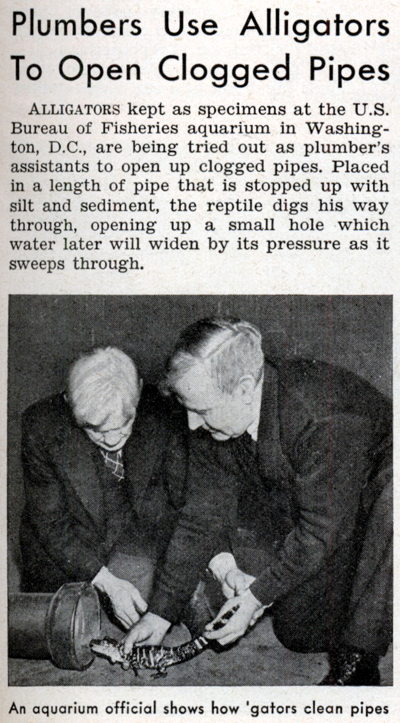This brief article ran in the Feb 1938 issue of
Popular Science magazine.
Plumbers Use Alligators To Open Clogged Pipes
Alligators kept as specimens at the U.S. Bureau of Fisheries aquarium in Washington, D.C., are being tried out as plumber's assistants to open up clogged pipes. Placed in a length of pipe that is stopped up with silt and sediment, the reptile digs his way through, opening up a small hole which water will widen by its pressure as it sweeps through.
A clipping of the article was posted on the
Modern Mechanix blog in April 2007, with the comment, "I guess we know now where that urban legend about alligators in the sewer started." The clipping has subsequently circulated on various blogs.
By chance, I know the back story to this news report. The guy on the left was
Fred Orsinger, Director of the (now defunct)
National Aquarium in DC during the 1930s and 40s. He had a reputation for being the P.T. Barnum of the fish world and was always pulling bizarre, tongue-in-cheek stunts to get the National Aquarium in the news.
For instance, in 1940 he founded something he called the
Association for the Prevention of April Fool Jokes (it was through this that I first came across references to him). The association didn't have anything to do with fish, but it got his name (and the aquarium) in the news.

Fred Orsinger
Some of his other schemes involved promoting the A.F.E.O.I.A.M.Y.W.T. (Association for Eating Oysters in Any Month You Want To), which tried to convince people that it was okay to eat oysters in months without the letter 'R'.
He campaigned to dispel the notion that all Fish Tales (i.e. stories that fishermen tell) are tall tales. He claimed to have found that, on average, only 2 out of 9 fish tales are untrue.
He promoted the Association for the Abolition of Round Fish Bowls, arguing that "round bowls distort a small, harmless fish into a ferocious denizen of the deep, producing a bad effect on children."
In 1937 he claimed he was going to stage a "fish walkathon" featuring the
Anabas Testudineus (the "walking or climbing perch").
In 1945 he claimed to have spotted a 20-foot sea monster in the Potomac River. He called it Percival.
One time he made a panther-skin coat for a Maine trout and claimed it was an actual
fur-bearing trout. Supposedly this fooled some Russian ichthyologists before "someone dragged them aside and whispered, 'it's a joke, comrade.'"
As for the pipe-cleaning alligators, an Associated Press article from October 1937 (can't find a link to an online copy) explains the genesis of the idea:
Orsinger said he conceived the idea when a drain pipe became clogged at a friend's home and it appeared it would be necessary to rip up the kitchen floor.
An alligator was placed in one end of the drain. It worked its way through the pipe and emerged at the other end.
"Alligators, you know, don't do backwards," Orsinger explained.
Elated, he has developed a sort of alligator-pipe size arrangement.
A 14-inch alligator, for instance, should do the job in a 6-inch pipe.
Apparently it's a myth that alligators can't walk backwards. Although it's surprisingly hard to find authoritative information on this subject. A search of science journal articles turned up nothing. But
pawnation.com offers this info:
The most common form of movement for alligators on land is called the “belly crawl,” and while an alligator cannot walk backwards on its belly, there is another form of movement that allows backwards motion: the “high walk.” When an alligator is high walking, its entire body and the majority of its tail is off the ground. This form of locomotion is used primarily when an alligator is getting out of water or moving over an obstruction, but it also allows alligators to move backwards.
So if this is true, Orsinger's scheme to use alligators to clean pipes might actually work, because the gators wouldn't be able to do the 'high walk' in a clogged pipe, and thus would have to move forward.



Comments